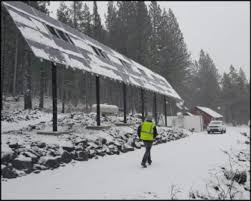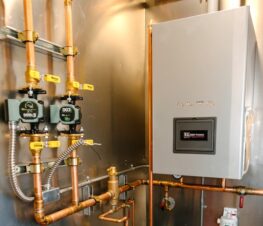Propane and solar complement each other to reduce emissions, increase resiliency
 When it comes to reducing emissions for commercial construction projects, no single energy source is the answer. Using different energy sources together is the best way to reduce emissions and increase resiliency. Construction professionals and their customers can use propane and solar energy together to reduce their carbon footprint and remain resilient. After all, commercial buildings account for nearly 35 percent of the electricity consumed in the United States.
When it comes to reducing emissions for commercial construction projects, no single energy source is the answer. Using different energy sources together is the best way to reduce emissions and increase resiliency. Construction professionals and their customers can use propane and solar energy together to reduce their carbon footprint and remain resilient. After all, commercial buildings account for nearly 35 percent of the electricity consumed in the United States.
Solar is the most common renewable energy source. However, relying on intermittent solar power alone isn’t sustainable. That’s where propane can help. Propane on its own is a viable energy solution, and when used with hybrid systems that include solarPV, the combination further reduces emissions and increases reliability. Here’s what you need to know about both systems and how they complement each other:
Propane and solar are a powerful combination.
Most construction professionals already know that solar power is a clean energy option; but most buildings can’t rely just on solar technology. Using propane and solar together, is an excellent way to reduce emissions while meeting a customer’s energy needs. On the continuum of energy choices, from clean to dirty, propane is closer to cleaner renewables than it is to dirtier coal, oil, and wood. Propane produces 43 percent fewer greenhouse gas emissions than using an equivalent amount of electricity generated by the U.S. grid. That’s because propane is used as a primary energy source on site.
Propane-powered technologies produce fewer nitrogen oxide (NOx) and sulfur oxide (SOx) emissions than technologies fueled by electricity, gasoline, and diesel. Because NOx and SOx contribute to acid rain formation and cause respiratory ailments, manufacturers must comply with laws limiting these emissions.
Together, propane and solar are resilient.
Construction professionals are installing large solar systems to help lower price premiums when grid electricity is more expensive and reduce emissions. However, solar power is only feasible if the sun is out. For true cost control and reliability, businesses need to consider adding propane power to help keep their operation running clean and efficiently if their solar power system can’t handle the full load.
When builders combine propane alongside solar, they provide customers with the resilience of whole-building standby protection. For example, propane standby generators are permanently installed on-site, providing quiet, efficient, and clean peace of mind. Power kicks in almost instantly when needed so there’s no disruption to critical systems like heating and cooling, lighting, or refrigeration.
The more energy dense systems that are powered by propane, the less solar energy it needs to run LED lights and fans. Incorporating propane into major systems for building heating and water heating will decrease the amount of solar power necessary, which creates a more cost efficient and resilient solution.
A new study from PERC called, Power Generation: The Emissions Shifting Problem, looks at the recent trends in power generation, microgrids, and how propane systems and solar can work together. Microgrids help improve the resiliency of local electricity distribution systems, that’s part of why they’re growing in popularity. They represent a groundbreaking approach that helps solve several of the problems facing California’s cities.
To provide an alternate power solution to customers located in Mariposa County, solar energy company BoxPower and generator manufacturer Generac provided solar PV with battery backup and a propane generator as a solution to reduce wildfires in one of California’s high-risk areas. Instead of ruggedizing the transmission and distribution (T&D) lines, which could cost more than one million dollars per mile in remote locations, electric utilities deenergized the T&D lines and installed these microgrid solutions to avert forest fires
These microgrid systems are one example of how using propane and solar provide peace of mind. They help businesses increase safety and resiliency, allowing them to retain their clean operation even with a power failure.
For contractors interested in improving a building’s carbon footprint in an affordable and reliable way, propane is a viable energy solution. Using propane with solar power systems reduces emissions and increases reliability. Visit Propane.com to learn more about the benefits of using propane in your next project.

Bryan Cordill is director of residential and commercial business development for the Propane Education & Research Council. He can be reached at bryan.cordill@propane.com.




Join the conversation: